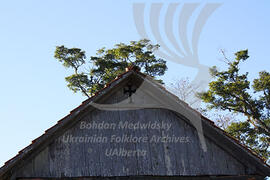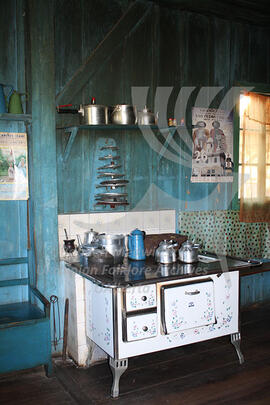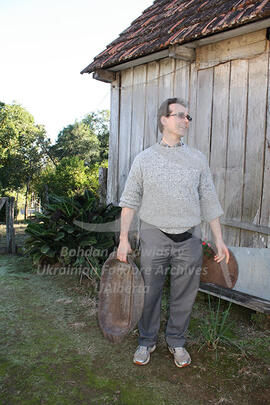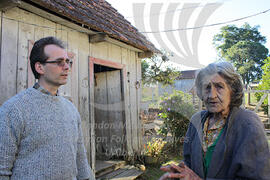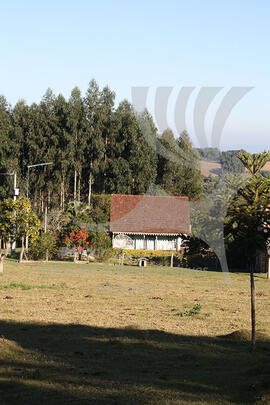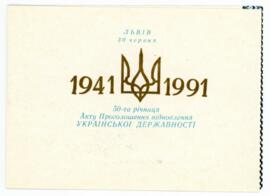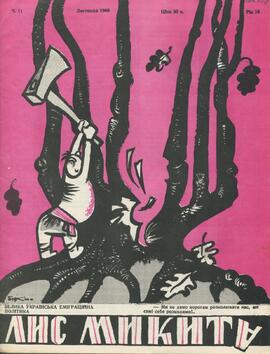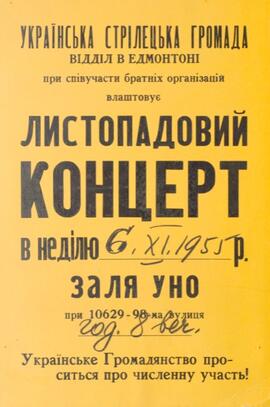The cross on the roof of the barn
Kitchen of Lozovei's house (cooking stove, cookware)
Kitchen of Lozovei's house (cooking stove, cookware, calendars, table, benches)
Andriy Nahachewsky is holding a trough
Andriy Nahachewsky is speaking to Vira Lozovei
The house of Lozovei's neighbos built in modern village style
The collection consist of a photograph and audio recording of the talk Lubomyr Romankiw gave for the Edmonton Plast parents during annual Sviato Vesny (Spring Celebration) organized by Edmonton Plast at the Elk Island National Park in East Central Alberta on May 30, 2015. Dr. Romankiw speaks about Plast, its creation, and activities in the past and today in Ukraine and diaspora communities around the world.
Romankiw, LubomyrA collection of lullabies used by three informants with a brief account of the use of lullabies in the Ukraine. bib., quest.
Popiwchak, Maria2 invitations to the Lviv for June 30 - Commemoration of 50 years since the Act of declaring the restoration of Ukrainian statehood (1941-1991)
The collection consists of 147 issues of the satirical and humour magazine "Lys Mykyta" published in Detroit by Edward Kozak. He started publishing it in 1948, after he emigrated to Germany after the WWII. In 1949 he settled in the United States, and resumed publishing Lys Mykyta in 1951.
Kozak, EdwardUkrainian Organizations organize a concert at the UNF hall, Edmonton.
- V.Makar, “Roman Shukhevych-Chuprynka” (Liha Vyzvolennia Ukrainy, Holovna Uprava), 1975.
- Roman Malashchuk. “Kruty, 1918 - 29.I.1967.”
- David R. Marples. “Taras Shevchenko's Ukraine.” March 8, 1992.
- Mykhailo Marunchak. “Na porozi 90-richchia ukrains'koho poselennia y Kanadi.”
- Oleksander Maslianyk. “Oseredok N.T.Sh. na Zakhidnu Kanadu,
ioho istoriia ta diial'nist'.” - “Inzh. Volodymyr M. Mats'kiv ta ioho nainovishi uspikhy.”
- Oleksandr Maslianyk (?). "Oseredok N.T.Sh. na zakhidniu Kanadu z osidkom v Edmontoni."
- "Promo iepyskopa Ukraїns'koї Pravoslavnoї Tserkvy Vsevoloda Maidanskoho na Synodi UHKTs"
- Nina Mryts. "Ukraїnska dytiacha knyzhka - dopomizhnyi vykhovnyi zasib," Dopovid' vyholoshena na Vykhovnomu Seminari v Toronti, 1962.
- About Ivan Mazepa: "Het'man Ivan Mazepa" (Orhanizatsiia Ukraїnok Kanady - Tsentralna Uprava).
- M. Marynchak. Sorok Rokiv Komitetu Ukraїntsiv Kanady na peredovii storozhi ukraїns'koї kul'tury i samobutnosty." Dopovid' vyholoshena na 13-omu Kongresi Ukraintsiv Kanady, Winnipeg, 11 zhovtnia 1980.
- Mykhailo Marunchak. "Sluzhba Bozha ta posviachennia Khresta Svobody."
Books and magazines form Yanda's collection include:
- Siryi, Iurii. Ukraina zemlia moikh bat'kiv. New York, 1952
- Velyka Istoriia Ukrainy. Vydannia Ivana Tyktora. Manitoba, Winnipeg
- Woycenko, Ol'ha. U rokovyny 70-littia Zhinochoho rukhu. Soiuz Ukrainok Kanady: Alberta, Edmonton, 1954
- Iliustrovanyi Kaliendar "Ukrains'koho Holosu": prysviachenyi organizatsiinii pratsi ukrains'koho zhinotstva v Kanadi 1934. Ukrains'kyi Holos, Ukrainian Publishing Company of Canada, Ltd.: Manitoba, 1934
- Iliustrovanyi kaliendar "Ukrains'koho Holosu" 1952. Ukrains'kyi Holos, Ukrains'ka vydavnycha spilka v Kanadi: Manitoba, Winnipeg, 1952
- Kaliendar Kanadiis'koho Farmera 1952. Kanadiis'kyi farmer: Manitoba, 1952
- Iliustrovanyi kaliendar "Ukrains'koho Holosu" na 1932 rik. Ukrains'kyi Holos, Ukrains'ka vydavnycha spilka v Kanadi: Manitoba, Winnipeg, 1932
- Chast' kaliendarna: Kaliendar "Ukrans'koho Holosu". Ukrains'kyi Holos, Ukrains'ka vydavnycha spilka v Kanadi: Canada, Manitoba, Winnipeg, 1930
- Iliustrovanyi Kaliendar "Ukrains'koho Holosu": prysviachenyi organizatsiinii pratsi ukrains'koho zhinotstva v Kanadi 1934. Ukrains'kyi Holos, Ukrainian Publishing Company of Canada, Ltd.: Canada, Manitoba, 1934
- Nova khata: [zhurnal dlía plekannia domashn'oi kul'tury]. Kooperatyva "Ukrains'ke narodnie mystetstvo." Europe: Ukraine, L'viv obl., L'viv, 1925-1939 (43 issue)
The project consists of the materials collected for Nataliya Bezborodova's master thesis. The thesis traces Internet textual representations of the Maidan, a wide-scale protest movement that took place in 2013-2014 in Ukraine, and their function in identifying the opposing sides during the protests. These texts helped to formulate new narratives, articulate attitudes, and build relationships, create a sense of community within the protestors’ side, which had its impact on institutional changes of commemorative practices.
Facebook served as an important platform for the initial appeal, for coordination between the participants, for reflections, and for identification of the opposing sides during the protests. It was a key space for sharing emotions, personal stories, humor and expressive forms of protest, making allusions to known literary works, historical events and world public figures.
Exploring the types of narratives and their contribution in identifying the opposing sides, the work is focused on digital stories that illuminate elements not covered by the professional media coverage and official reports. It traces the diverse forms, topics and expressive devices in the narratives, and identifies the categories of lore (eyewitness narratives, (re)telling of stories, jokes, poetry, songs, etc.). It provides juxtaposition of the patterns found in the text with the main events of each specific day.
The thesis provides several chapters that focus on: (1) a review of the historical context of the events; (2) an analysis of the data with reference to all categories and topics, and the main findings; (3) the role of humor and expressive devices in releasing the tension of the conflict and in helping to formulate the attitudes within the protestors’ side; (4) evidence of the functions of personal stories as they build relationships, create a sense of community, and validate the participants’ experiences and the significance of the events from the protestors’ perspectives; (5) interpretation within this protest lore, and its impact on institutional changes of commemorative practices as in the example of the Nebesna Sotnia (Heavenly Hundred) narrative formation and its correlation to the repertoire of motifs and terms of the selected historical periods: the Cossack, the Ukrainian National Republic and World War II.
The study underlines the relevance of time and several patterns related to historical events, as Facebook posts immediately responded to the events occurring on the square and streets occupied by protestors, simultaneously with professional media outlets, and sometimes prior to them. These findings have important implications that go beyond the Ukrainian context in that they contribute to the further exploration of social networks functioning in relation to factual events.
